 Lyme disease, transmitted by a deer tick (the tick-borne spirochete, Borrelia burgdorferi), stands as the most common vector-borne disease in the U.S., with more than 30,000 cases reported annually. Moreover, recent estimates suggest this number is under-reported and that the actual incidence in the U.S. may be tenfold higher. A recent case report reminds clinicians of the importance of early recognition and treatment of Lyme carditis.
Lyme disease, transmitted by a deer tick (the tick-borne spirochete, Borrelia burgdorferi), stands as the most common vector-borne disease in the U.S., with more than 30,000 cases reported annually. Moreover, recent estimates suggest this number is under-reported and that the actual incidence in the U.S. may be tenfold higher. A recent case report reminds clinicians of the importance of early recognition and treatment of Lyme carditis.
Grace E. Marx, MD, MPH, an epidemic intelligence officer at the Centers for Disease Control & Prevention (CDC), Fort Collins, Colo., and colleagues published their description of two fatal cases of Lyme carditis online October 2019 in the Annals of Internal Medicine.1 The authors note neither of the patients from New England received the empiric antibiotics, which are recommended when Lyme carditis is suspected. Instead, the physicians ordered Lyme testing and continued to investigate the symptoms.
First, the authors describe a 57-year-old man from Vermont who presented to a primary care physician after one week of fever, fatigue, shortness of breath and chest pain. Twelve days after presentation and before the scheduled appointment with an infectious disease physician, the patient was found unresponsive and subsequently died.
The second case was a 49-year-old woman from Massachusetts who presented to an emergency department with severe headache, nausea and vomiting. Seventeen days later, after further appointments with a primary care physician and cardiologist but before the patient took her first dose of doxycycline, she was found unresponsive and ultimately died.
After these deaths, the CDC conducted histopathologic evaluations of postmortem heart tissue and found lymphohistiocytic pancarditis with immunohistochemical and molecular evidence of B burgdorferi in both patients.
In 2017, the CDC published a report updating the available information on the epidemiology of Lyme disease cases and highlighted the continuing public health challenges associated with it. Although the 2017 report documented stable to decreasing case counts, the authors noted this trend may reflect modifications in state reporting practices that result in decreased Lyme disease surveillance. The report also noted that Lyme disease was spreading and emerging in states neighboring those already known to have a high incidence.2
The CDC recommends healthcare providers consider a diagnosis of Lyme disease in patients with compatible clinical signs and a history of potential exposure to infected ticks—not only in known areas of Lyme disease, but also in areas where Lyme disease is emerging. Lyme disease is most often seen during the early summer months. In high incidence states, the confirmed cases occur most among males with a modal age in young children.


